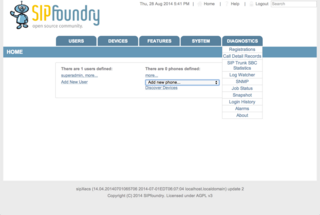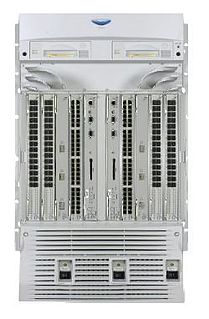The Digital Private Network Signalling System (DPNSS) is a network protocol used on digital trunk lines for connecting to PABX. It supports a defined set of inter-networking facilities.
A virtual local area network (VLAN) is any broadcast domain that is partitioned and isolated in a computer network at the data link layer. In this context, virtual, refers to a physical object recreated and altered by additional logic, within the local area network. VLANs work by applying tags to network frames and handling these tags in networking systems – creating the appearance and functionality of network traffic that is physically on a single network but acts as if it is split between separate networks. In this way, VLANs can keep network applications separate despite being connected to the same physical network, and without requiring multiple sets of cabling and networking devices to be deployed.
The data link layer, or layer 2, is the second layer of the seven-layer OSI model of computer networking. This layer is the protocol layer that transfers data between nodes on a network segment across the physical layer. The data link layer provides the functional and procedural means to transfer data between network entities and may also provide the means to detect and possibly correct errors that can occur in the physical layer.

The DMS-100 is a member of the Digital Multiplex System (DMS) product line of telephone exchange switches manufactured by Northern Telecom. Designed during the 1970s and released in 1979, it can control 100,000 telephone lines.

In computer networking, link aggregation is the combining of multiple network connections in parallel by any of several methods, in order to increase throughput beyond what a single connection could sustain, to provide redundancy in case one of the links should fail, or both. A link aggregation group (LAG) is the combined collection of physical ports.

sipXecs is a free software enterprise communications system. It was initially developed as a proprietary voice over IP telephony server in 2003 by Pingtel Corporation in Boston, MA, and later extended with additional collaboration capabilities in the SIPfoundry project. Its core feature is a software implementation of the Session Initiation Protocol (SIP), which makes it an IP based communications system.

EtherChannel is a port link aggregation technology or port-channel architecture used primarily on Cisco switches. It allows grouping of several physical Ethernet links to create one logical Ethernet link for the purpose of providing fault-tolerance and high-speed links between switches, routers and servers. An EtherChannel can be created from between two and eight active Fast, Gigabit or 10-Gigabit Ethernet ports, with an additional one to eight inactive (failover) ports which become active as the other active ports fail. EtherChannel is primarily used in the backbone network, but can also be used to connect end user machines.

Nortel Meridian is a private branch exchange telephone switching system. It provides advanced voice features, data connectivity, LAN communications, computer telephony integration (CTI), and information services for communication applications ranging from 60 to 80,000 lines.
Provider Backbone Bridge Traffic Engineering (PBB-TE) is an approved telecommunications networking standard, IEEE 802.1Qay-2009. PBB-TE adapts Ethernet technology to carrier class transport networks. It is based on the layered VLAN tags and MAC-in-MAC encapsulation defined in IEEE 802.1ah, but it differs from PBB in eliminating flooding, dynamically created forwarding tables, and spanning tree protocols. Compared to PBB and its predecessors, PBB-TE behaves more predictably and its behavior can be more easily controlled by the network operator, at the expense of requiring up-front connection configuration at each bridge along a forwarding path. PBB-TE Operations, Administration, and Management (OAM) is usually based on IEEE 802.1ag. It was initially based on Nortel's Provider Backbone Transport (PBT).
Passport Carrier Release (PCR) is a version of the Passport Switch software designed to run in telecommunications carrier environments. It was formerly developed by Nortel. After the sale in 2009 of most Nortel's assets, the passport SW is still used in several products of Alcatel-Lucent, Ericsson and Kapsch.

Multi-link trunking (MLT) is a link aggregation technology developed at Nortel in 1999. It allows grouping several physical Ethernet links into one logical Ethernet link to provide fault-tolerance and high-speed links between routers, switches, and servers.
InterSwitch Trunk (IST) is one or more parallel point-to-point links that connect two switches together to create a single logical switch. The IST allows the two switches to share addressing information, forwarding tables, and state information, permitting rapid fault detection and forwarding path modification. The link may have different names depending on the vendor. For example, Brocade calls this an Inter-Chassis Link (ICL). Cisco calls this a VSL.

Metro Ethernet Routing Switch 8600 or MERS 8600 is a modular chassis router and/or switch manufactured by Nortel now acquired by Ciena. The MERS 8600 supports the Provider Backbone Bridges (PBB), Provider Backbone Transport (PBT) technologies and carrier class Operations Administration & Maintenance (OAM) tools.
In network routing, the control plane is the part of the router architecture that is concerned with drawing the network topology, or the information in a routing table that defines what to do with incoming packets. Control plane functions, such as participating in routing protocols, run in the architectural control element. In most cases, the routing table contains a list of destination addresses and the outgoing interface(s) associated with each. Control plane logic also can identify certain packets to be discarded, as well as preferential treatment of certain packets for which a high quality of service is defined by such mechanisms as differentiated services.
Simple Loop Prevention Protocol (SLPP) in computer networking is a Data Link Layer protocol developed by Nortel to protect against Layer 2 network loops. SLPP uses a small hello packet to detect network loops. The SLPP protocol checks packets from the originating switch and the peer switch in a SMLT configuration. Sending hello packets on a per VLAN basis allows SLPP to detect VLAN based network loops for un-tagged as well as tagged IEEE 802.1Q VLAN link configurations. If a loop is detected, the associated port is shut down.
The Nortel Discovery Protocol (NDP) is a Data Link Layer network protocol for discovery of Nortel networking devices and certain products from Avaya and Ciena. The device and topology information may be graphically displayed network management software.
Avaya Unified Communications Management in computer networking is the name of a collection of GUI software programs from Avaya utilizing a service-oriented architecture (SOA) that serves as a foundation for unifying configuration and monitoring of Avaya Unified Communications Servers and data systems.

Avaya Virtual Services Platform 9000 Series or VSP 9000 is a set of modular chassis switches used in enterprise and data center networks, manufactured by Avaya. The VSP 9000 is used by institutions which are suffering from performance limitations, need to simplify their network infrastructure in a virtualized environment, or require 10 Gigabit Ethernet today with the option to scale to 40 or 100 Gigabit Ethernet in the future. It is also an option for companies who are looking to reduce the power and cooling cost in order to maximize the cost-effectiveness of their infrastructures; this unit was also designed and is expected to have a lifespan of seven-to-ten years. In 2013 the Olympics network backbone is built with VSP 9000 Switches supporting 30,000 users and up to 54 terabits per second of traffic.







